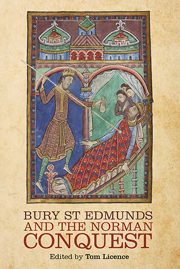Book contents
- Frontmatter
- Contents
- LIST OF ILLUSTRATIONS
- LIST OF MUSIC EXAMPLES
- LIST OF CONTRIBUTORS
- ACKNOWLEDGMENTS
- LIST OF ABBREVIATIONS
- Introduction
- 1 The Abbey and the Norman Conquest an Unusual Case?
- 2 Charters and Influences from Saint-Denis c. 1000–1070
- 3 The Abbey's Armoury of Charters
- 4 The Women of Bury St Edmunds
- 5 Baldwin's Church and the Effects of the Conquest
- 6 New Light on the Life and Work of Herman the Archdeacon
- 7 The Cult of St Edmund
- 8 St Edmund Between Liturgy and Hagiography
- 9 Books and their Use Across the Conquest
- 10 An Eleventh-Century Bury Medical Manuscript
- 11 Medicine at Bury in the Time of Abbot Baldwin
- 12 Medicine After Baldwin: The Evidence of BL, Royal 12. C. xxiv
- Index
10 - An Eleventh-Century Bury Medical Manuscript
Published online by Cambridge University Press: 05 August 2014
- Frontmatter
- Contents
- LIST OF ILLUSTRATIONS
- LIST OF MUSIC EXAMPLES
- LIST OF CONTRIBUTORS
- ACKNOWLEDGMENTS
- LIST OF ABBREVIATIONS
- Introduction
- 1 The Abbey and the Norman Conquest an Unusual Case?
- 2 Charters and Influences from Saint-Denis c. 1000–1070
- 3 The Abbey's Armoury of Charters
- 4 The Women of Bury St Edmunds
- 5 Baldwin's Church and the Effects of the Conquest
- 6 New Light on the Life and Work of Herman the Archdeacon
- 7 The Cult of St Edmund
- 8 St Edmund Between Liturgy and Hagiography
- 9 Books and their Use Across the Conquest
- 10 An Eleventh-Century Bury Medical Manuscript
- 11 Medicine at Bury in the Time of Abbot Baldwin
- 12 Medicine After Baldwin: The Evidence of BL, Royal 12. C. xxiv
- Index
Summary
Some ten years ago I identified an eleventh-century Continental medical manuscript in the British Library (Sloane 1621) as a hitherto unrecognised Bury book. It is a small book of several contemporary parts that is interesting for its content, its many contemporary, near-contemporary, and early twelfth-century additions by Continental and English scribes, and the likelihood that it should be linked to Baldwin, abbot of Bury between 1065 and 1097. Its content is discussed by Debby Banham in the following chapter, and therefore what follows is concerned mostly with the physical and scribal features of the manuscript, and the conclusions concerning its origin and provenance that can be drawn from them.
At the beginning of Sloane 1621 is a preliminary quire, formerly of four leaves but now with its first leaf lost (fols 2–4), of slightly later date than what follows. The quire contains medical prayers and three short texts concerning the monochord in two Anglo-Continental hands, probably of the early twelfth century, the second of which also made an addition on the last leaf of the manuscript proper (fol. 111r). There is little reason to doubt that the quire was an early addition to the manuscript, for its format (arrangement and number of lines) suggests that it was made with the intention to put it before what follows. At the top of what is now the opening page (fol. 2r) is a one-word twelfth-century title repeated by the same scribe (antidotarius), and this is an adequate description of the content of the manuscript proper, suggesting that the preliminary quire was in its present position by at least 1200, if not before.
- Type
- Chapter
- Information
- Bury St Edmunds and the Norman Conquest , pp. 190 - 225Publisher: Boydell & BrewerPrint publication year: 2014

